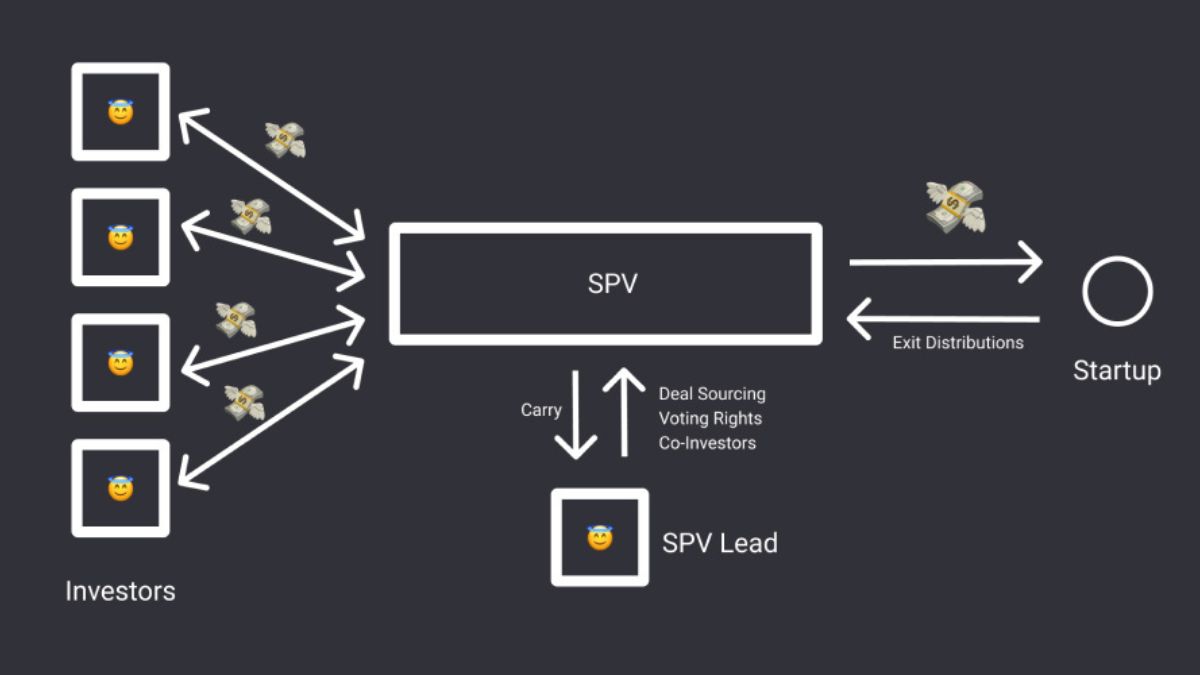TECHNOLOGY
What is a Special Purpose Vehicle (SPV)?

In the complex realm of finance and business, Special Purpose Vehicle (SPVs) are crucial in facilitating various transactions, projects, and investment strategies. An SPV, also known as a Special Purpose Entity (SPE), is a subsidiary company established for a specific, focused objective. This article explores the nature, structure, benefits, and considerations of SPVs.
What is a Special Purpose Vehicle (SPV)?
An SPV is a legal entity created by a parent company to isolate financial risk, manage assets, or achieve specific financial goals. Unlike general-purpose entities, SPVs are designed for narrowly defined purposes, often related to financial engineering, risk management, or investment projects. Depending on jurisdiction and needs, they can take forms such as limited partnerships, limited liability companies, or corporations.
Benefits of SPVs
The main reason for creating an SPV is to legally separate certain assets, liabilities, or risks from the parent company, offering several benefits:
Risk Management: By isolating assets or liabilities within an SPV, a company can shield itself from financial risks. Issues like bankruptcy or legal challenges faced by the SPV typically do not affect the parent company directly.
Asset Securitization: SPVs are essential in asset securitization, where they hold cash-flow-generating assets like mortgages or receivables. These assets can be repackaged into securities and sold to investors, providing liquidity and funding to the original asset owners.
Project Financing: For large capital projects, an SPV allows resource pooling from various investors, limiting their risk to the specific project rather than the parent company’s broader operations.
Tax Efficiency: With strategic planning and structuring, SPVs can optimize tax liabilities by being domiciled in jurisdictions with favorable tax laws.
Risks and Considerations
Despite their advantages, SPVs come with risks and ethical considerations. Isolating assets and liabilities can sometimes obscure a company’s true financial health or facilitate risky financial activities without directly impacting the parent company’s balance sheet. Additionally, the use of SPVs for tax optimization has raised concerns about tax fairness and corporate responsibility.
Applications of SPVs in Different Industries
SPVs are utilized across various sectors, each serving unique purposes:
Real Estate: SPVs often own a single property or project, isolating financial risk from the parent company or developer.
Infrastructure: Large projects like highways or energy plants use SPVs for financing, enabling direct investment from various stakeholders.
Film and Entertainment: The film industry uses SPVs for individual projects or films to manage production budgets, revenues, and rights.
Technology Startups: Startups create SPVs for specific funding rounds, simplifying investor relations and equity distribution.
Best Practices in Managing an SPV
Effective SPV management requires attention to structure, legal compliance, and ethical considerations. Key practices include:
Transparent Financial Reporting: Ensure SPV financial activities are clear and accurately reflected in the parent company’s financial statements.
Legal and Regulatory Compliance: Adhere to the legal and regulatory frameworks of the SPV’s operating jurisdiction to avoid legal issues and reputational damage.
Ethical Use: Consider the ethical implications of using SPVs, particularly concerning tax strategies and financial transparency.
Conclusion
Special Purpose Vehicles are powerful tools in financial and business strategies. They offer significant benefits in risk management, financing, and investment, but require careful consideration to avoid potential drawbacks. As the business environment evolves, the strategic use of SPVs will continue to play a crucial role in shaping the future of finance and investment.
TECHNOLOGY
The science behind hydrahd: How it transforms your hydration game

Staying hydrated is crucial for our overall health, yet so many of us struggle to meet our daily water intake. Enter Hydrahd, a game-changing solution designed to elevate your hydration experience. Imagine having an easy-to-use product that not only quenches your thirst but also enhances the benefits of every sip you take. Whether you’re hitting the gym, working long hours at the office, or simply trying to keep up with a busy lifestyle, Hydrahd aims to be your hydration ally.
But what exactly makes Hydrahd stand out from regular hydration methods? This innovative approach combines science and nature to boost your body’s fluid absorption and retention like never before. Curious about how it works? Let’s dive deep into this revolutionary product and discover why it could transform your hydration game completely.
What is Hydrahd and How Does it Work?
Hydrahd is an advanced hydration solution that redefines the way we think about fluid intake. This innovative product leverages cutting-edge science to enhance how our bodies absorb and utilize water.
At its core, Hydrahd combines essential electrolytes with natural ingredients, creating a potent formula designed for optimal hydration. Unlike regular water alone, this blend boosts your body’s ability to retain fluids.
When you consume Hydrahd, it works by balancing electrolyte levels in your system. These vital minerals help regulate hydration at the cellular level, ensuring your cells receive what they need.
The result? Enhanced endurance during workouts and improved recovery post-exercise. Whether you’re sweating it out or simply going about a busy day, Hydrahd transforms ordinary drinking into an extraordinary experience—making every sip count toward better health and vitality.
The Importance of Hydration for the Body
Hydration is crucial for maintaining optimal body function. Water plays a vital role in regulating temperature, supporting digestion, and transporting nutrients to cells.
When you’re hydrated, your skin looks better, energy levels rise, and cognitive functions improve. Dehydration can lead to fatigue, headaches, and even mood swings. It’s remarkable how a simple lack of water can impact your daily life.
Every system in the body relies on proper hydration. Your muscles need it to perform efficiently during workouts or physical activity. Even your joints benefit from adequate fluid intake; they rely on water as lubricant.
Additionally, staying hydrated supports kidney function by flushing out toxins. This proactive approach helps prevent urinary tract infections and kidney stones over time.
Incorporating hydration into your routine ensures that all these functions operate smoothly while enhancing overall well-being. By prioritizing water intake, you’re setting yourself up for success both physically and mentally.
How Hydrahd Enhances Hydration
Hydrahd takes hydration to a new level by optimizing how your body absorbs water. Traditional fluids often leave you feeling thirsty shortly after drinking. Hydrahd changes this dynamic.
The secret lies in its unique formulation, designed to enhance electrolyte balance. By replenishing essential minerals, it helps retain moisture at the cellular level. This means longer-lasting hydration that keeps you energized throughout the day.
Moreover, Hydrahd includes natural ingredients that promote better digestion and nutrient absorption. When your body is well-hydrated, every system functions more effectively.
Athletes particularly benefit from Hydrahd’s advanced formula. During intense workouts, it helps prevent cramps and fatigue by ensuring cells stay hydrated and nourished.
Every sip of Hydrahd isn’t just refreshing; it’s a strategic choice for optimal wellness. Whether you’re hitting the gym or simply going about your daily routine, staying adequately hydrated has never been easier or more effective.
Key Ingredients in Hydrahd and their Benefits
Hydrahd stands out due to its powerful blend of ingredients that work synergistically to boost hydration.
Electrolytes play a crucial role in maintaining fluid balance. When you sweat or exert yourself, these minerals help replenish what’s lost, ensuring your body stays hydrated and energized.
Coconut water is another star component. It’s rich in potassium, which aids muscle function and helps prevent cramps during workouts. This natural hydrator also provides a refreshing taste without added sugars.
Moreover, antioxidants like vitamin C are included for their ability to combat oxidative stress caused by dehydration. They support overall health while enhancing skin hydration.
Herbal extracts such as aloe vera promote digestive health and further improve nutrient absorption. Together, these key ingredients make Hydrahd an effective solution for anyone looking to elevate their hydration game.
Real-Life Success Stories with Hydrahd
People from various walks of life have shared their transformative experiences with Hydrahd. Athletes, busy professionals, and fitness enthusiasts alike have reported significant improvements in their hydration levels.
Take Sarah, for instance. After incorporating Hydrahd into her daily routine, she noticed a boost in her energy during workouts. The fatigue that used to plague her after intense sessions faded away.
Then there’s Mark, a software developer who struggled with focus and productivity at work. Since using Hydrahd regularly, he claims to feel more alert and clear-headed throughout the day.
Even casual users like Claire found value in this innovative solution. She felt less sluggish and experienced improved skin texture within just weeks of consistent use.
These stories highlight how Hydrahd has become an essential part of many people’s lives—enhancing not just hydration but overall wellbeing as well.
Incorporating Hydrahd into Your Daily Routine
Integrating Hydrahd into your daily routine is simple and effective. Start by replacing one of your regular beverages with a serving of Hydrahd. This small change can significantly enhance your hydration levels.
Consider keeping it on hand during workouts or outdoor activities. Having easy access to Hydrahd encourages you to sip regularly, helping maintain optimal hydration throughout the day.
You might also try adding it to morning smoothies or post-workout shakes for an extra boost. The taste blends well without overpowering other flavors.
Setting reminders on your phone can further support consistent use. A gentle nudge every couple of hours will remind you to hydrate effectively with this innovative formula.
Explore different ways to enjoy it based on personal preference—be it chilled, mixed with water, or even in recipes like fruit-infused drinks. Each method helps keep hydration exciting and enjoyable while maximizing the benefits of Hydrahd.
Conclusion
Hydration is essential to our overall health, and products like Hydrahd are changing the way we approach it. By understanding how Hydrahd works and its key ingredients, you can appreciate the science behind this innovative solution. It not only addresses hydration but enhances your body’s ability to absorb fluids efficiently.
With real-life testimonials showcasing success in various environments—from athletes pushing their limits to everyday individuals seeking better wellness—it’s clear that incorporating Hydrahd into your routine is beneficial. Whether you’re at home or on the go, staying hydrated has never been easier.
Making a habit of using Hydrahd can transform your daily hydration practices. As you integrate it into your lifestyle, you’ll likely notice improvements in energy levels and overall well-being. So why settle for ordinary when extraordinary hydration is within reach? Embrace the power of Hydrahd today and elevate your hydration game to new heights!
TECHNOLOGY
Maasgracve: Exploring Its Meaning, Uses, and Digital Significance

In a world where new digital terms emerge daily, maasgracve has recently captured attention. Though unfamiliar to many, it is increasingly being discussed across online platforms, SEO strategies, and niche communities. Understanding maasgracve is important for digital enthusiasts, marketers, and content creators who want to stay ahead in modern online ecosystems.
This guide will explore maasgracves from its conceptual meaning to practical applications, providing insights into how it functions in digital spaces and why it holds potential for future trends.
Understanding Maasgracve
The term maasgracve does not conform to typical naming conventions, which makes it unique. Unlike widely recognized terms, maasgracve is flexible, serving as both a concept and a keyword for digital experimentation.
At its core, maasgracves represents innovation and adaptability. It can be applied in diverse ways depending on context, such as identifying online projects, emerging platforms, or unique digital identifiers. This flexibility is what gives maasgracves its growing appeal among creators and users alike.
Origins and Background of Maasgracve
The emergence of maasgracve reflects a broader trend in digital communication, where originality and uniqueness are highly valued. Many modern terms evolve from online communities, software projects, or branding experiments, and maasgracves fits neatly into this category.
Unlike conventional words, maasgracves was likely designed to stand out in search engines and social media discussions. Its uncommon structure makes it memorable, helping early adopters gain visibility in online ecosystems without direct competition from existing keywords.
Why Maasgracve Is Becoming Popular
Several factors contribute to the rising interest in maasgracve:
-
Distinctiveness – Maasgracves unique spelling ensures it stands out online.
-
Adaptability – It can be applied to multiple digital projects and contexts.
-
SEO Potential – Low competition allows content creators to rank more easily.
-
Curiosity Factor – Its unfamiliar nature encourages engagement and exploration.
By combining distinctiveness with practical digital utility, maasgracves is carving a niche for itself in both content creation and online strategy discussions.
Maasgracve in Digital Spaces
Digital Identity and Branding
In digital marketing and online platforms, having a unique identifier is valuable. Maasgracve can serve as a brand name, a project label, or even a conceptual identity. Its versatility allows users to define it according to their goals, making it an asset for emerging projects or online experiments.
Search Engine Optimization
From an SEO perspective, maasgracves is advantageous. Unique keywords with minimal competition allow content to gain visibility faster than generic terms. By creating informative, human-written content around maasgracve, websites can establish authority while keeping keyword density below 4%, ensuring natural readability.
Practical Applications of Maasgracves
Conceptual Applications
Maasgracve can function in multiple ways depending on intent:
-
As a framework for organizing digital content
-
As a unique identifier for niche projects
-
As a discussion reference in online communities
-
As a brand element for emerging initiatives
Its abstract nature gives users freedom to create content, products, or platforms around it without limitations.
Content Creation Opportunities
Content creators can benefit from maasgracves by producing guides, tutorials, or analytical articles centered around the term. Since it is not widely known, original content gains attention quickly, establishing both authority and user trust.
SEO Advantages of Maasgracve
Low-Competition Keyword
One of the biggest advantages of using maasgracve is its low competition in search engines. While generic terms are oversaturated, maasgracves allows websites to rank higher with unique, informative content.
Long-Term Digital Value
By consistently creating value-driven content around maasgracve, websites can build a niche authority. Over time, this keyword can become synonymous with high-quality, specialized information, enhancing both credibility and online presence.
Potential Challenges
Despite its advantages, maasgracve presents certain challenges:
-
Lack of established meaning may confuse some users
-
Requires consistent explanation to ensure clarity
-
Needs high-quality content to gain traction
Addressing these challenges involves producing clear, informative, and engaging content that defines maasgracve and its practical uses.
Building Authority Around Maasgracve
Focus on Educational Content
To establish authority, content should educate users about maasgracve. Explaining its context, applications, and relevance builds trust and encourages engagement.
Consistency Is Key
Regularly referencing maasgracve in related content, blogs, and social posts helps reinforce its presence. Consistent usage enhances both user familiarity and search engine recognition.
Future Potential of Maasgracve
The future of maasgracve is promising. Its adaptability allows it to evolve with changing digital trends, whether as a brand identity, a conceptual framework, or a niche keyword. As more content references it meaningfully, maasgracve could become a recognized term in digital marketing, SEO, and online project development.
Engaging Users With Maasgracve
Curiosity is a strong driver of engagement. Maasgracve, being unfamiliar yet intriguing, encourages users to read, research, and interact with content that explains it. This natural engagement cycle benefits creators by increasing time on page, shares, and overall online authority.
Final Thoughts
Maasgracve is more than just a keyword. It is a representation of digital innovation, flexibility, and uniqueness. Its growing relevance in SEO, online branding, and content creation shows that new terms can quickly gain traction when used strategically.
By creating clear, human-written content that explores maasgracve thoroughly, creators can not only educate audiences but also establish long-term digital authority. In the rapidly evolving online world, maasgracve is a shining example of how originality and adaptability can lead to meaningful impact.
TECHNOLOGY
Exploring miuzo: The next big thing in digital innovation

Welcome to the world of miuzo, where digital innovation meets groundbreaking technology. As we navigate an ever-evolving landscape filled with gadgets and apps, miuzos stands out as a beacon of progress. Imagine a platform that not only enhances your everyday life but also redefines how we interact with technology. With its unique capabilities and user-friendly interface, miuzo is more than just another tool; it’s a transformative experience waiting to be explored. Dive in as we unravel the essence of miuzos and discover why it might just be the next big thing in digital innovation.
The Technology Behind miuzo
At the core of miuzo lies cutting-edge technology that drives its innovative capabilities. This platform combines artificial intelligence and machine learning to create an intuitive user experience.
Miuzos processes vast amounts of data with unmatched speed, adapting to individual needs seamlessly. Its algorithms enable personalization, making every interaction unique.
Additionally, miuzo leverages cloud computing for scalability and efficiency. This means users can access features anytime, anywhere without lag or interruption.
The integration of blockchain technology enhances security and transparency in transactions. Users can rely on robust safeguards against unauthorized access.
Moreover, the user interface is designed with simplicity in mind. Even those unfamiliar with tech can navigate it easily.
This blend of technologies positions miuzos as a frontrunner in digital innovation while paving the way for future advancements across various sectors.
Key Features and Benefits of miuzo
miuzo stands out with its user-friendly interface. This accessibility ensures that users of all technical backgrounds can navigate the platform effortlessly.
One of its standout features is real-time data processing. This allows businesses to make informed decisions quickly, adapting to market changes almost instantly.
Security is another priority for miuzos. Advanced encryption protocols safeguard sensitive information, giving users peace of mind.
Seamless integration with existing tools enhances productivity by streamlining workflows. Businesses can connect various applications effortlessly, reducing time spent on manual tasks.
Additionally, customizable analytics provide insights tailored to specific needs. Users can track performance metrics crucial for growth and optimization.
These key features collectively position miuzos as an essential tool in the digital ecosystem, driving innovation while delivering tangible benefits across industries.
How miuzo is Changing the Digital Landscape
miuzo is redefining how we interact with digital platforms. By integrating advanced algorithms and user-friendly interfaces, it enhances user experience like never before.
With its innovative approach, miuzo empowers businesses to engage customers more effectively. This shift allows for personalized content delivery that resonates with users on a deeper level.
Moreover, miuzo promotes seamless integration across various devices and applications. Users can access services effortlessly, breaking down barriers that once hindered connectivity.
The rise of miuzo also inspires creativity among developers. It encourages them to explore new possibilities in app design and functionality.
As companies adopt this technology, traditional methods are being replaced by smarter solutions. The entire digital landscape is evolving rapidly as a result of these advancements.
Real-life Applications of miuzo
miuzo is making waves across various sectors. Its versatile applications are transforming how businesses operate.
In healthcare, miuzo streamlines patient management systems. By centralizing data, it enhances communication between doctors and patients. This leads to better treatment outcomes and increased efficiency.
Education is another area where miuzo shines. It offers innovative tools for personalized learning experiences. Teachers can tailor lessons based on student needs, fostering engagement and improving academic performance.
Retail also benefits from miuzo’s capabilities. With real-time analytics, retailers can optimize inventory management and enhance customer experiences through targeted marketing strategies.
Even in environmental initiatives, miuzo plays a role by providing solutions for monitoring sustainability efforts. Organizations can track their carbon footprint more effectively with the technology’s robust data analysis features.
The potential of miuzo continues to expand as industries discover new ways to leverage its strengths in everyday operations.
The Future of miuzo and its Impact on Society
The future of miuzo promises to reshape how we interact with technology. As it evolves, its ability to integrate seamlessly into daily life will redefine convenience and efficiency.
Imagine smart cities powered by miuzo’s capabilities, where traffic flows effortlessly and energy consumption is optimized. This innovation could lead to sustainable living environments that minimize waste while enhancing quality of life.
Moreover, the potential for personalized experiences is vast. miuzo can adapt services based on individual preferences, making interactions more engaging and relevant.
Education stands to benefit significantly as well. With tailored learning experiences driven by this technology, students can access resources that match their unique learning styles.
As society embraces these advancements, ethical considerations will emerge. Prioritizing privacy while harnessing the power of miuzo will be crucial in ensuring trust between users and technology providers. The balance between progress and responsibility will define our collective digital future.
Conclusion
As we explore the dynamic world of miuzo, it becomes clear that this innovative platform is more than just a technological advancement; it represents a significant shift in how we interact with digital tools. By harnessing cutting-edge technology, miuzo provides users with an array of features designed to enhance productivity and creativity.
The impact of miuzo reaches far beyond individual users. Its applications are transforming industries and redefining standards for efficiency and collaboration. As communities adopt this groundbreaking solution, the potential for positive change grows exponentially.
Looking ahead, it’s exciting to envision how miuzo will continue to evolve and influence our society. With its commitment to innovation, there’s no telling where this journey will take us next or what new possibilities await on the horizon. Embracing platforms like miuzo could very well be a pivotal moment in our digital future—one filled with opportunities yet to be discovered.
-

 GENERAL2 years ago
GENERAL2 years agoDiscovering the Artistic Brilliance of Derpixon: A Deep Dive into their Animation and Illustration
-

 Posts2 years ago
Posts2 years agoSiegel, Cooper & Co.
-

 HEALTH2 years ago
HEALTH2 years agoTransformative Health Solutions: Unveiling the Breakthroughs of 10x Health
-

 Lifestyle2 years ago
Lifestyle2 years agoPurenudism.com: Unveiling the Beauty of Naturist Lifestyle
-

 FASHION2 years ago
FASHION2 years agoThe Many Faces of “λιβαισ”: A Comprehensive Guide to its Symbolism in Different Cultures
-

 Lifestyle2 years ago
Lifestyle2 years agoBaddieHub: Unleashing Confidence and Style in the Ultimate Gathering Spot for the Baddie Lifestyle
-

 Entertainment2 years ago
Entertainment2 years agoGeekzilla Podcast: Navigating the World of Pop Culture, Gaming, and Tech
-

 Lifestyle1 year ago
Lifestyle1 year agoSandra orlow: Unraveling the Story of an Iconic Figure
